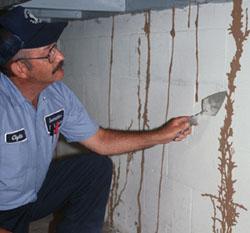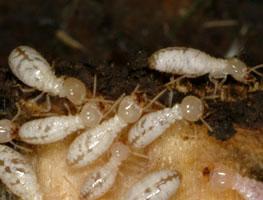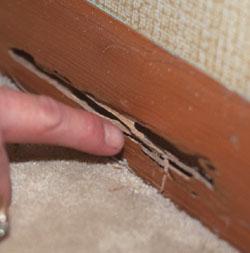Entomology departments often receive more calls about termites than any other household insect. Subterranean termites are serious pests, whose control is best left to professionals. Termites and termite management services can be confusing, however, and there are more options available today than ever before. Some of the most common termite questions raised by homeowners are answered below.
- Why worry about termites?
- Why are infestations often discovered during March – May?
- How will I know if my home is infested?
- Can I treat the house myself?
- How do I choose a termite control company? Why is there such variance in price?
- Which treatment methods and products are most effective?
- Does the entire house need to be treated — or can they just treat areas where I see termites?
- How long will the treatment last?
- Will the chemicals harm my family or pets?
- Have I been “cheated” if termites continue to infest my house after treatment?
NOTE: The answers contained in this publication are based on conditions and regulations as they exist in Kentucky, USA. Timing of termite appearance and regulatory/legal considerations may be different in your local area. You may also wish to consult your local cooperative extension agency or government department about specific recommendations for your area.
Q: Why worry about termites?
A: Termites cause billions of dollars in damage each year. They primarily feed on wood, but also damage paper, books, insulation, and even swimming pool liners and filtration systems. Termites can injure living trees and shrubs, but more often are a secondary invader of woody plants already in decline. While buildings may become infested at any time, termites are of particular importance when buying or selling a home since a termite inspection/infestation report is normally a condition of sale. Besides the monetary impact, thousands of winged termites emerging inside one’s home are an emotionally trying experience — not to mention the thought of termites silently feasting on one’s largest investment.
 Winged termites emerging indoors are a
Winged termites emerging indoors are a
sure sign that the building is infested.
Q: Why are infestations often discovered during March – May?
A: Spring typically is when large numbers of winged termites, known as “swarmers,” emerge inside homes. In nature, termites swarm to disperse and start new colonies. Triggered by warmer temperatures and rainfall, the winged termites emerge from the colony and fly into the air.
The swarmers then drop to the ground, shed their wings, pair off with a mate, and attempt to begin new colonies in the soil. Few swarmers emerging outdoors survive to start new colonies. Swarmers emerging indoors are incapable of eating wood, seldom survive, and are best removed with a vacuum. They do, however, indicate that an infestation is present.
Q: How will I know if my home is infested?
A: Discovering winged termites indoors almost always indicates an infestation warranting treatment.

Ant vs. Termite
People often confuse winged termites with ants, which often swarm at the same time of year. Termites can be differentiated by their straight antennae, uniform waist and wings of equal size. (Ants have elbowed antennae, constricted waists and forewings that are longer than the hind wings.)
The swarmers are attracted to light and are often seen around windows and doors. Termite swarmers emerging from tree stumps, woodpiles, and other locations out in the yard are not necessarily cause for concern, and do not necessarily mean that the house is infested. On the other hand, if winged termites are seen emerging from the base of a foundation wall or adjoining porches and patios, there’s a good chance the house is infested also and treatment may be warranted.

Termite Mud Tubes
Other signs of infestation are earthen (mud) tubes extending over foundation walls, support piers, sill plates, floor joists, etc. The mud tubes are typically about the diameter of a pencil, but sometimes can be thicker.
Termites construct these tubes for shelter as they travel between their underground colonies and the structure. To help determine if an infestation is active, the tubes may be broken open and checked for the presence of small, creamy-white worker termites.
If a tube happens to be vacant, it does not necessarily mean that the infestation is inactive; termites often abandon sections of tube while foraging elsewhere in the structure.

Termite Workers
Termite-damaged wood is usually hollowed out along the grain, with bits of dried mud or soil lining the feeding galleries. Wood damaged by moisture or other types of insects (e.g., carpenter ants) will not have this appearance. Occasionally termites bore tiny holes through plaster or drywall, accompanied by bits of soil around the margin. Rippled or sunken traces behind wall coverings can also be indicative of termites tunneling underneath.
Oftentimes there will be no visible indication that the home is infested. Termites are cryptic creatures and infestations can go undetected for years, hidden behind walls, floor coverings, insulation, and other obstructions. Termite feeding and damage can even progress undetected in wood that is exposed because the outer surface is usually left intact.

Termite damage to baseboard. Hidden infestation was discovered when
vacumn cleaner attachment penetrated surface of baseboard.
Confirmation of infestation often requires the keen eye of an experienced termite inspector. However, even the most experienced inspector can overlook infestation or damage which is hidden.

Drilling Treatment
Q: Can I treat the house myself?
A: Ridding a home of termites requires special skills. A knowledge of building construction is needed to identify the critical areas where termites are likely to enter. Many of these potential points of entry are hidden and difficult to access. Termite control also utilizes specialized equipment such as masonry drills, pumps, large-capacity tanks, and soil treatment rods. A typical treatment may involve hundreds of gallons of a liquid pesticide, known as a termiticide, injected into the ground alongside the foundation, beneath concrete slabs, and within foundation walls.
In short, termite treatment is a job for professionals. A possible exception would be if a mailbox post, sandbox or other small wooden object not attached to the house was infested. “Do-it-yourself” products, sold to homeowners at retail stores or bought over the internet, will seldom eradicate an existing termite problem.
Q: How do I choose a termite control company? Why is there such variance in price?
A: These are complex questions. The company should be licensed by the Department of Agriculture or agency responsible for regulating termite control in the state. Membership in their state pest control association and/or National Pest Management Association suggest the company is an established firm with access to technical and training information needed to do the job correctly. As with any service company, references are invaluable. Consider calling at least 2-3 companies. Requesting inspections and estimates from more than one will help verify the existence of a termite problem and allow you to compare services.
Companies offer different types of treatment methods and warranties. If termites happen to return, most will retreat the affected area(s) at no additional charge. Some companies also will repair damage occurring subsequent to their treatment, although dating onset of damage is a hard thing to determine. In some cases, no warranty will be offered if wells, cisterns, subslab heating ducts, drainage systems, or inaccessible crawl spaces make it impossible to treat in accordance with industry standards.
Take your time when selecting a company. Termites damage wood slowly; the amount of damage caused by taking an additional day, week, or month to make an informed decision generally is insignificant. Avoid firms that try to pressure you into signing a contract immediately with “specials” or scare tactics. The overall quality of the job depends less on the sales person than on the individual who does the work. A safe and effective treatment requires an experienced technician, not someone who was hired a few weeks ago.
Q: Which treatment methods and products are most effective?
A: Another challenging question. There are two general categories of termite treatment, liquids and baits. Soil-applied liquid termiticides have been around for decades. Their purpose is to provide a long-lasting chemical barrier that excludes termites in the ground from entering buildings. In most cases, termites in the structure die off as well, since they cannot return to the soil. Most former products wererepellent rather than lethal to termites foraging in the soil. Newer materials, such as Premise® (imidacloprid), Termidor® (fipronil), and Phantom® (chlorfenapyr), are non-repellent and termites tunneling into the treatment zone are killed. Overall the non-repellent products are proving to be more reliable in their ability to resolve termite problems in the first attempt. All registered termiticides (both repellent and non-repellent) can be effective, however, and homeowners should not base their purchasing decision on product alone.
The other broad treatment category is baiting. Termite baits consist of paper, cardboard, or other palatable food, combined with a slow-acting substance lethal to termites. The baits are installed below ground out in the yard in cylindrical plastic stations. Others are sometimes placed indoors over active mud tubes. Foraging termites consume the bait and share it with their nestmates, resulting in a gradual decline in termite numbers. On some properties, baits may constitute the only form of treatment; on others, they may be combined with liquid applications. to areas where termites are observed.
Termite baiting is a very complex subject. For further information, see our entomology extension publications, Entfact 639: Termite Baits: A Guide for Homeowners. Regardless of which method or product is selected, it’s important to have an experienced technician, backed by a responsible pest control firm.
Q: Does the entire house need to be treated… or can they just treat areas where I see termites?
A: Subterranean termite colonies may contain hundreds of thousands of individuals, foraging in many different directions. For the homeowner, localized or “spot” treatments are generally a gamble except in cases of retreatment. Most reputable pest control firms will not warranty spot treatments, since it’s likely that termites will eventually find other points of entry into the structure.
Some companies may offer to do a so-called “perimeter” treatment, using one of the non-repellent liquid termiticides (Termidor, Premise, etc.). Typically this will involve a thorough application around the entire outside foundation wall of the building, and spot-treating any infested or high-risk interior areas. If the homeowner is considering such a treatment, they should inquire whether it will be accompanied by a service agreement in case termites return. (Service renewal agreements usually state that if termites return, the company will return and retreat the affected areas at no additional charge provided the renewal agreement is maintained.) It’s a bit of a gamble to purchase any termite treatment option without an ongoing service agreement.
Q: How long will the treatment last?
A: All liquid termiticides are supposed to control termites for at least five years when applied according to label directions. The actuallength of control on a given structure will depend on such factors as thoroughness of the application, environmental conditions, and density of termites in the area. If termites swarm again and continue to be a problem the year after treatment, it’s usually not from degradation of the termiticide — but because termites have found an untreated gap in the chemical barrier.
Q: Will the chemicals harm my family or pets?
A: Termiticides are tested extensively for adverse effects on health. Before a product can be used, numerous studies are conducted by the manufacturer and independently evaluated by the U.S. Environmental Protection Agency. Based on the current body of knowledge, registered termiticides pose no significant hazard to humans, pets or the environment when applied according to label directions. Despite the negligible health risk from a properly performed termite treatment, people with lingering concerns should consult their physician. Most of the newer liquid products have essentially no odor. Clients who are still apprehensive may want to consider having their home treated with baits.
Q: Have I been “cheated” if termites continue to infest my house after treatment?
A: Not necessarily. Unlike other services such as plumbing or electrical work, termite control involves living creatures. The best treatments performed by knowledgeable firms may fail at times, when termites find their way through tiny, untreated gaps in the soil. While the intent is to establish a continuous, impenetrable chemical barrier, this is all but impossible to achieve in actual practice. In the case of baits, it may take several months for termites to initially find the below-ground installations and several months more to achieve control.
The key is to hire a reputable pest control firm employing experienced, conscientious technicians. Companies will return and retreat affected area(s) at no additional charge provided the service agreement is purchased and maintained.
Issued: 5/92
Revised: 3/04
CAUTION! Pesticide recommendations in this publication are registered for use in Kentucky, USA ONLY! The use of some products may not be legal in your state or country. Please check with your local county agent or regulatory official before using any pesticide mentioned in this publication.
Of course, ALWAYS READ AND FOLLOW LABEL DIRECTIONS FOR SAFE USE OF ANY PESTICIDE!

















 Winged termites emerging indoors are a
Winged termites emerging indoors are a Ant vs. Termite
Ant vs. Termite Termite Mud Tubes
Termite Mud Tubes Termite Workers
Termite Workers
 Drilling Treatment
Drilling Treatment

